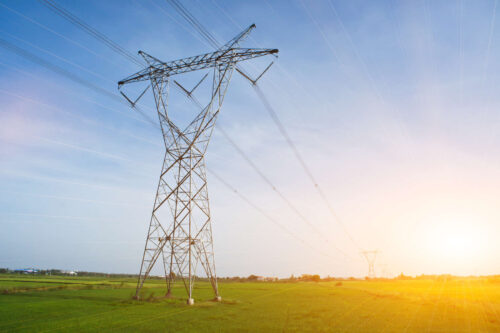SONY DSChigh voltage post, High-voltage tower.

The Best Time to Plan Transmission Was 15 Years Ago. The Second-Best Time Is Now.
A host of recent decarbonization studies provides mounting evidence for two things: First, it is both technically feasible and economically sound to decarbonize the US economy. Second, the required transformation entails substantial infrastructure investments. While the United States has vast potential for low-cost and zero-carbon wind and solar power, the best and least-cost locations for these resources tend to be far from where most people live and consume energy. To decarbonize cost-effectively, we therefore need to rapidly build out the long-range transmission lines that can carry wind and solar power from where it is produced to where it is consumed.
Yesterday, the Federal Energy Regulatory Commission (FERC) took important steps to address key barriers to building the transmission infrastructure we need. The announced Notice of Proposed Rulemaking (NOPR) would require “regional planning on a sufficiently long-term, forward-looking basis to meet transmission needs driven by changes in the resource mix and demand.” Additionally, FERC appears to be encouraging grid planners to allocate the cost of new transmission by recognizing its diverse benefits, which would be an important improvement over the narrow benefits definitions that are common today.
Growing Consensus on the Value of Transmission
Princeton’s Net-Zero America study suggests that transmission capacity needs to at least double and probably triple to decarbonize the entire US economy. MIT researchers Patrick R. Brown and Audun Botterud calculate that a fully renewable US power system would be about half as costly overall, if we roughly double transmission capacity within and between different US regions. Vibrant Clean Energy finds that large transmission investments are needed even if we co-optimize locally distributed (including rooftop or community solar) and utility-scale (i.e., large but distant wind and solar farms) solutions. These studies suggest that, even without growing loads from electrifying transportation, buildings, and industry, the US transmission system needs to expand by 50 to 90 percent to achieve President Biden’s goal of 100 percent clean electricity by 2035. With extensive electrification and economy-wide decarbonization, they suggest we will need to at least double or even triple today’s transmission system.
Unfortunately, the United States is currently not planning the transmission needed for a rapidly shifting resource mix and increasing demand. According to Americans for a Clean Energy Grid, there are 22 significant shovel-ready transmission projects in the United States today. If all 22 were built, they would add only 11 to 12 percent to today’s transmission capacity.
Problems with Regional Transmission Planning Today
Inadequate planning is one of the primary causes of today’s insufficient transmission. One unfortunate result is that many new generation projects are bogged down in lengthy interconnection queues, which contain about 1,000 GW of mostly wind and solar capacity, along with over 400 GW of storage. Even today, many grid planners, including both large regional transmission organizations and vertically integrated monopoly utilities, assume unrealistically slow growth of low-cost solar and wind in their grid planning processes. Further, grid planners typically focus on their local grids rather than planning jointly with neighboring grids, which would save cost and add reliability. Finally, most planning processes do not adequately account for transmission’s broad benefits, such as improved reliability, economic efficiency, resilience to extreme weather events, and emissions reductions. Not including the full suite of transmission’s benefits makes the difficult question of “who pays” even more difficult to answer. When cost-benefit analyses define transmission’s wide benefits too narrowly, it becomes all but impossible to properly identify all the beneficiaries.
Supporting New Investments in Transmission
With its proposed rule, FERC is taking important steps to address key barriers in regional transmission planning:
- FERC would require grid planners to consider long-term needs, including a changing generation mix and demand, when planning regional transmission. FERC would also require planners to consider factors such as federal, state, and local laws and regulations, technology trends and fuel costs, resource retirements, generator interconnections, and extreme weather events.
- The proposed FERC rule would enable (but not require) grid planners to consider a broader set of benefits of regional transmission facilities for the purposes of project selection and cost allocation. In FERC Chairman Rich Glick’s words, “transmission facilities provide a broad range of benefits.” If planners account for these benefits when allocating costs, it will be an important step in addressing the exceedingly narrow benefit definitions common in regional cost allocations today.
- In its announcement, FERC also suggested the inclusion of grid enhancing technologies (GETs) in regional planning. As research shows, GETs help the grid get more transfer capacity from both existing and new transmission lines.
We support FERC’s efforts to encourage the transmission investments the United States needs. In particular, we believe the improved regional transmission planning suggested by this NOPR is warranted and necessary. In its final rule, we encourage FERC to also require (not just suggest) that transmission’s broad benefits be included in cost allocation.
As FERC itself noted, there is still more work to do to encourage the transmission the United States needs. In particular, the US electricity system badly requires improvements in interregional transmission planning (i.e., between different regions of the country). Commissioner Mark Christie has previously expressed interest in the concept of establishing interregional transfer capacity minimums. This idea has been floated by several parties (including RMI) in their comments on FERC’s Advance Notice of Proposed Rulemaking (ANOPR) last year, which preceded this NOPR. Additionally, FERC must still tackle generator interconnection queue reforms. During his remarks at yesterday’s meeting, Chairman Glick also mentioned other remaining topics, which include FERC’s approach to transmission incentives and overseeing new transmission development to protect consumers.
We applaud FERC for its leadership on these vital issues for a clean, prosperous, and secure energy future for all — and hope it will continue drive progress in the clean energy transition.